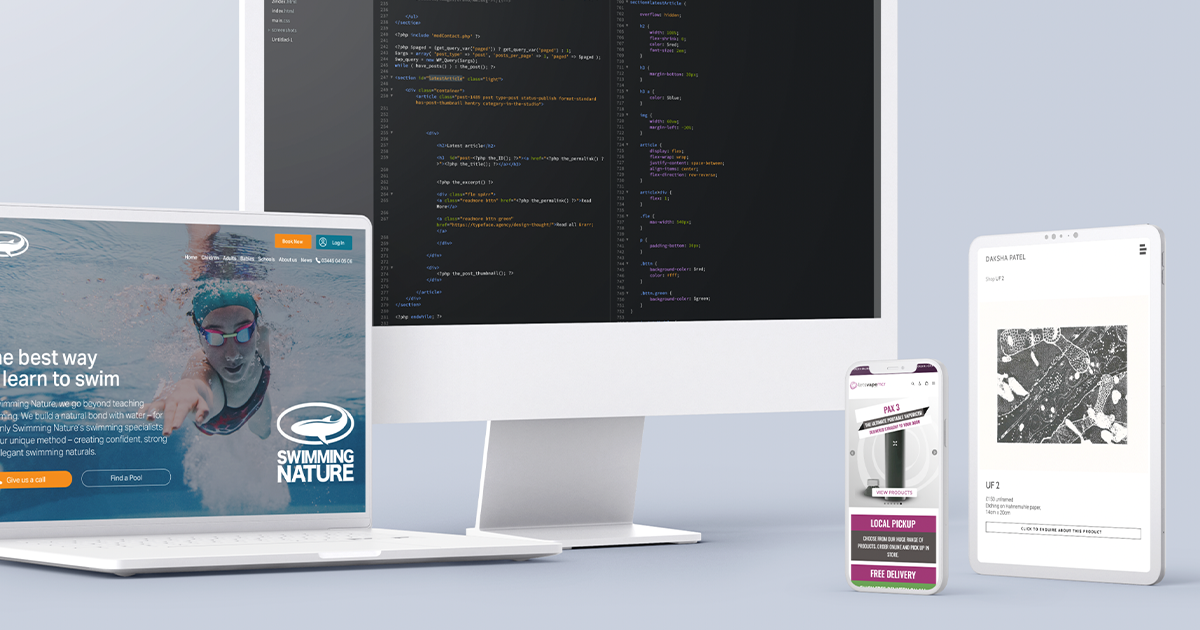This article is currently undergoing editing. This article talks about the four main systems and frameworks that Typeface uses to create client websites and why.
Jump to:
Typeface uses four main frameworks to deploy client websites; WordPress, Hubspot, WordPress & WooCommerce and Shopify. Each system has its pros and cons, which is something Typeface weighs up when suggesting technologies to clients.
From a production perspective, the wireframe, design and front end build stages of a project stay the same regardless of CMS. Once we have a working HTML version of the design, files are split up and built in to a template for use with the client’s CMS of choice and any dynamic functionality is added.
The basic coniderations:
- How hands on does the client want to be?
- How much time does the client have to invest?
- Does the client work with a third party for content creation, social or SEO?
- Are we creating an online shop or a digital storefront? i.e. does the website need to integrate with a physical space and track physical stock?
- Bricks and mortar stores looking to move online have their own hurdles and challenges: Does the client have existing picking and packing systems to integrate? Do we need to limit target areas for online search because of existing delivery networks? Are your products sanctioned or restricted in certain countries, do any of your products violate the Ts and Cs of your platform of choice or payment gateway?
The four main systems
WordPress

The Grandaddy of blogging systems, WordPress is one of the most powerful and easy to use CMS available. The most versatile off-the-shelf content management system and one of the most developer friendly, it has a passionate community driving development and it’s the platform that I’ve chosen to build the Typeface website on.
WordPress is an example of how open source communities can create powerful easy to use tools that adapt with their user base. WordPress powers 43% of the internet including corporations and companies such as Disney, Sony, Vogue, Rolling stone, UNICEF and literally thousands more enterprise level websites. I’ve worked on projects in the past with clients who were adamant that they weren’t going to use WordPress because they wanted something completely bespoke. Using this system doesn’t mean you can’t have a bespoke website, it means you’re not spending thousands reinventing the wheel on a CMS that’s going to do less, will need more maintenance, will be more expensive to expand and will tie you in to a developer. For 90% of client projects, WordPress is an ideal framework to build on.
I’ve been developing with WordPress for over a decade now at various studios because the number of features out of the box, scalability and sheer value that we could offer to clients was hard to ignore.
Pros
- WordPress websites can be self hosted, allowing the client to retain control of their data.
- With such a huge community of developers and supporters, the platform is kept up-to-date and secure.
- WordPress is PHP based which means the client isn’t tied in to one developer.
- A simple template structure means that new page designs and styles can easily be added in to any well-built theme.
- Scalability. A simple, standardised database structure means that entirely new website templates and designs can be built using existing content and new functions can be added by simply building a new theme, this is hugely beneficial for companies with large amounts of legacy content who need to upgrade their website and for companies going through rebrands who need to freshen up their look. It means that the current website can still be used and updated while the design and development phases of a project take place.
Cons
- WordPress works best with a supportive developer. Security updates and core updates are as simple as pressing a button, sometimes these things can be overlooked or ignored.
- The ability for clients to add in plugins for increased functionality can be too tempting for some. When possible Typeface will build extra functionality in to the website theme itself, this keeps things secure and fast.
- WordPress can feel daunting at first. Clients usually only interact with posts and pages so there’s an argument for locking down installs and restricting access to areas of the back end, but we can do this using user profile levels. It’s always good for the client to have at least one account with full administrator access allowing them to add new users in to the system and so this is what Typeface provides by default.
Hubspot

First and foremost Hubspot is a CRM tool. It’s built around a set of powerful automation features and analytics tools and offers out of the box functions such as live web chat, email automation, user persona profiling, download management, form tracking and meeting scheduling. The list of features is already exhaustive and it continues to grow as Hubspot refine their systems.
If you have a dedicated marketing team or you work with a PR Agency or content creation company, then Hubspot should be a serious consideration for your business.
Hubspot treats landing pages, website pages and blogs as their own marketing areas with their own sets of tools and analytics. Websites are built with stackable, modular sections in mind. This isn’t as limiting as it sounds; most websites will contain anything from 12-18 individual layout sections, most of which will be combined to create enjoyable, engaging experiences. A well-built Hubspot theme can allow clients to quickly build and assemble pages by dragging and dropping components. It’s a great system to use if your goal is to measure user statistics and interactions and tweak content and calls to action to fine-tune your engagement and conversions.
Pros
- Hubspot is the most complete CRM tool on the market.
- Content focused, making it a great tool for content teams to collaborate with.
- In-depth tracking and analytics for each website page, blog and landing page.
- Easy to create user groups and delegate notifications and access to sales, marketing and website teams.
- Suite of marketing and remarking tools, including email automation, live chat, mailing lists and document sharing.
- Ability to take payments.
- Ability to create separate landing pages for marketing campaigns.
Cons
- Things can get expensive the more features you need.
- Website files and data are stored on Hubspot’s servers.
- Hubspot uses a proprietary templating langage called Hubl. Although based on Java, this does limit the number of Hubspot developers.
Ecommerce
WooCommerce and Shopify are two of the most popular eCommerce platforms. WooCommerce is the best solution if you want to integrate a shopping cart and products system directly in to your website. If you’re more interested in a focused eCommerce experience, have a large number of products or need something to integrate with your POS and stock system; Shopify is the answer.
WooCommerce

Because its so versatile there are various cost effective ways of building an online store using WordPress. We could create a custom post type and add in products, integrating a Stripe checkout directly, or adding in PayPal buttons. However, if you’re running a WordPress website and you are looking to set up an online store then WooCommerce should be your first consideration.
One of the benefits of using a system like WooCommerce on a self hosted WordPress website is the vast assortment of payment gateways that can be integrated. Shopify has restrictions on the types of products that can be sold using their integrated checkout and while many payment gateways boast Shopify integration, some systems can be incomplete or rely on extra developer input to properly install. The costs of subscribing to a third party payment gateway can often offset profits for low margin products, which is why considering the costs of your payment system and the way it integrates with your platform early on is a good idea.
While it lacks some of the stock management and POS options that Shopify has, WooCommerce benefits from integrating directly with WordPress and its theme/templating system. This gives the developer much more control over how and where the shop and products can be integrated in to a bespoke website design.
Overloading a website with plugins is never recommended. That said WooCommerce is supported by a variety of extensions that can add flexibility and features if needed. Another benefit of running a WooCommerce store is easy integration with well-known WordPress SEO and optimisation plugins like Yoast.
Shopify

Shopify works best as a stand alone eCommerce solution.
Can I run a full website via Shopify?
Yes but it’s not something Typeface would recommend. Shopify excels in simplifying stock management, POS integration and product management with physical products, physical storage and the online space. It is not a publishing tool and as a full website CMS it falls short; but that isn’t the space that Shopify occupies. Shopify works best alongside a well built, well optimised website and offers a lot of tools as standard that would otherwise be costly or time consuming to implement.
Running Shopify via a subdomain
Maybe you already have a website and you’re weighing up the benefits of setting up a separate online store using Shopify’s system. Setting your shop up using a subdomain is a viable option which allows you to use the Shopify systems without sacrificing creativity when it comes to the look and feel of your main website.
From a user perspective shop.websitename.com keeps things on brand and as expected, however optimising for a subdomain will have less impact on the main website’s URL as it may be considered a separate website. Its something to think about if SEO is a consideration, especially if you’re focusing on the main branded URL in your Optimisation and Search campaigns. Because profit margins from online sales rely on scale, SEO is an important factor in whether an online store succeeds or fails. On projects where SEO is important from day one, Typeface works with Manchester based SEO expert Matt Davies so that clients can be sure any Search considerations will be baked in to development from day one, giving fresh websites a much needed jumpstart
The pitfalls of selling via a walled garden
Like Hubspot, Shopify offer a walled garden approach. This comes with it’s own set of pros and cons. In Hubspot’s case, all that user data is sat on their servers; the pro being that they handle everything GDPR related. In Shopify’s case, you have an easy to use, easy to integrate storefront but the products that they allow you to sell using their payment gateways are tied in to their Ts and Cs, which are country specific.
Tempting plug-ins and add-ons
Like WooCommerce, Shopify offers paid and free plugins to increase functionality. Many of these plugins and features come with $2-4 per month subscriptions which can easily stack up, eating in to profits. Sometimes you might want to add what would otherwise feel like a standard shopping cart feature or something that would be two-three lines of PHP for a WooComerce website only to find it as a paid plugin with a subscription. It is important to remember that Shopify has two client bases; plugin developers and store owners so the subscription model is much more prevalent with Shopify than with a WordPress system. This translates to ease-of-use by scarifying a granular level of customisation, making Shopify a powerful tool for the client but less so for the developer.








